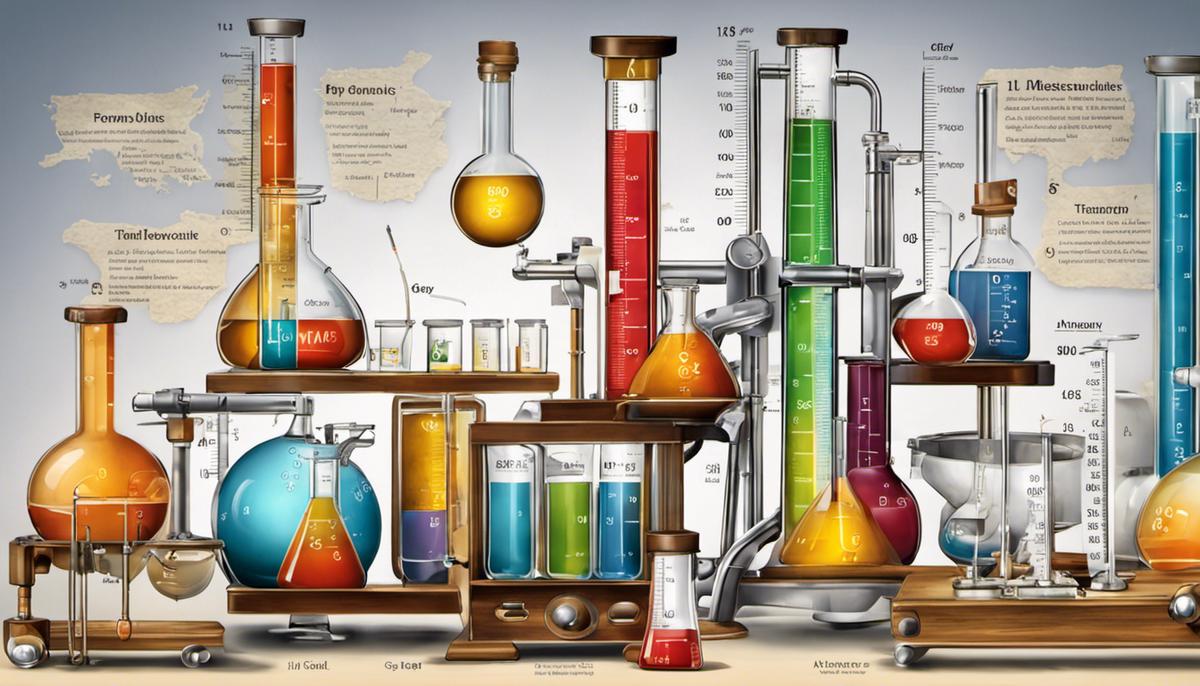Chemistry, the central science, hinges on the understanding and correct utilization of units of measurement. Ensuring consistency in scientific calculations worldwide, units of measurement are the fundamental building blocks in the field of chemistry. Spanning from basic concepts to complex applications, this exploration of units of measurement will guide you through their significance, use, conversion, and problem-solving applications in chemistry. Gain insights on the International System of Units (SI Units) – the standard system used by chemists worldwide – and familiarize yourself with common units like the mole, meters, kilograms, seconds, and Kelvin. By engaging with this, you’ll acquire the knowledge to convert units and apply them effectively in chemistry-related calculations.
Basic Concepts of Units of Measurement in Chemistry
Understanding Units of Measurement in Chemistry
Units of measurement are an elemental aspect of science, and the field of Chemistry is not an exception. These units are necessary for accurate descriptive and predictive scientific work. Measurements provide quantitative data, which aid in comparing observations and improving the precision of theoretical predictions.
Absolute measurements refer to quantities like time, temperature, and mass, which do not require to be related with other quantities for their understanding. For instance, ten grams is a definitive weight, regardless of what substance is being weighed. Relative measurements, on the other hand, measure one quantity in relevance to another. An example is density, which requires both mass and volume to be defined.
Units of measurement also allow for standardization across the field of Chemistry. This standardization makes it possible for different scientists to repeat or modify experiments conducted by others. Also, creating a standard universal system prevents discrepancies that could arise from using different unit systems.
The Adoption of SI Units in Chemistry
Science, including Chemistry, has accepted the International System of Units (SI Units) as the standard system for measurements. The system, developed by the Bureau International des Poids et Mesures (BIPM) in France in the 1960s, is based on seven base units. These units include the meter (m) for length, kilogram (kg) for mass, second (s) for time, ampere (A) for electric current, kelvin (K) for temperature, mole (mol) for amount of substance, and candela (cd) for luminous intensity.
Chemistry often utilizes derived units, which are combinations of these base units. For example, velocity is defined in meters per second (m/s), which are derived from the base units of meter (m) and second (s).
Chemical Quantities and SI Units
In Chemistry, the mole (mol) is a crucial base unit as it provides a way to express amounts of a chemical substance. It allows chemists to count entities at the atomic and molecular level. One mole of any substance contains the same number of entities (atoms, molecules, ions, or other particles), known as Avogadro’s number (approximately 6.022 x 10^23).
Other commonly used chemical units derive from SI base and derived units, such as liters for volume and grams for mass.
An Overview
The understanding and standardization of units of measurement are of paramount importance in the scientific discipline of Chemistry. The standardized measures facilitate a universal comprehension of results, breaking down barriers created by different countries, cultures, and languages. This unanimity accelerates the global advancement of scientific knowledge.

Common Units of Measurement in Chemistry
Exploring Units of Measurement in Chemistry
Chemistry, like all other science domains, is heavily dependent on standardized units of measurement to articulate the quantities of various elements or compounds. A fundamental measurement unit in chemistry is the mole (mol), the basic unit for quantity in the International System of Units (SI). Essentially, a mole corresponds to the number of atoms present in exactly 0.012 kilograms of Carbon-12, equating to approximately 6.022 x 10^23, a value famously known as Avogadro’s number.
For length, the metric used generally in laboratory settings is the meter (m). However, when describing the minute dimensions of atoms and molecules, subunits like nanometers (10^-9 meters) or picometers (10^-12 meters) are often utilized. These units make these incredibly small values manageable for scientific research.
Mass, an inherent property of matter, is typically quantified in kilograms (kg) in the SI system. However, in chemistry, smaller measures like grams (g) and milligrams (mg) are more common due to the typically lesser quantities used.
Time, a universal physical quantity, is employed across various areas within chemistry, such as in tracking reaction rates or determining the half-lives of unstable isotopes. The second (s) is the SI system’s primary unit of time.
Temperature is another crucial variable in many chemical processes. Scientists generally use the Kelvin (K) scale to measure temperature while Celsius (°C) is commonly used in laboratories. The Kelvin scale begins from absolute zero, the lowest achievable temperature, hence making it suitable for rigorous thermodynamic calculations.
Another unit specific to chemistry is concentration, typically presented in the form of molarity (mol/L). Molarity conveys the number of solute moles within a liter of solution. This unit proves particularly handy when undertaking calculations related to solution reactions.
Lastly, the energy unit in the SI system is the joule (J). In chemistry, it is also frequent to express energy in terms of calories (cal) or kilocalories (kcal), particularly when referring to heat energy.
Familiarizing oneself with these units and their usage is crucial for accurately understanding chemical data, carrying out calculations, and validating theories. Each unit plays a critical role in deciphering and interpreting the vast realm of Chemistry.

Conversion of Units in Chemistry
Expanding the Scope: Units of Measurement in Chemistry
In chemistry, units of measurement encompass an extensive range of categories, including distance, mass, volume, energy, and significantly, number of particles. Elements such as the intensity of interactions, rate of chemical reactions, and quantification of distinct physical properties are all expressed through these units. A thorough understanding of these units forms an essential cornerstone in the mastery of chemical science.
Significance of Conversion Factors
Conversion factors play an essential role in chemistry. Essentially, a conversion factor is a ratio that expresses how one unit of measurement equates to another. It’s used to convert a given unit in one form to another equivalent form without adjusting the quantity’s value. The conversion factor is derived by taking the relationship between two units and expressing this relationship as a fraction. Conversion factors have a value of one, since they express a relationship between two equivalent measurements.
Application of Conversion Factors in Chemistry
Conversion factors are commonly used in chemistry for various calculations. For instance, chemists use Avogadro’s number (6.02 x 10^23), a conversion factor, to convert between number of particles such as atoms, ions, molecules, and moles. The mole is a standard unit in chemistry and can be defined as the amount of substance that contains as many entities (atoms, molecules or other particles) as there are in 12 grams of pure carbon-12.
A specific example would be converting grams to moles using the molar mass of a substance. If you know the molar mass, you could use it as a conversion factor to convert grams of the substance to moles. For instance, in carbon with a molar mass of approximately 12g/mol, 1 mole of carbon is equivalent to 12 g. So if you had 24 g of carbon, you could use the conversion factor of (1 mol/12g) to determine that you have 2 moles of carbon.
Conversion in Chemical Equations and Reactions
Conversion factors are also used in the stoichiometry of chemical reactions. Stoichiometry is the relationship between reactants and products in a chemical reaction. One mole of a substance produces or consumes a specific number of moles of another substance according to the balanced chemical equation.
For example, in the combustion of hydrogen gas to form water (2H2 + O2 → 2H2O), two moles of hydrogen gas react with one mole of oxygen gas to produce two moles of water. Hence, using conversion factors, you can determine the amount of product (in moles) produced from a given amount of reactants or the amount of reactants needed to produce a certain amount of product.
Conversion factors and measurement units lay the foundation of every scientific computation in the field of chemistry. Expertise in these tools enables chemists to measure and interpret the natural phenomena precisely, enhancing their communication. Their usage spans from rudimentary laboratory calculations to advanced theoretical modeling of chemical reactions. Grasping these foundational concepts opens doors to a wider exploration and research in chemistry.

Problem Solving Using Units of Measurement
Grasping the Fundamentals of Measurement Units in Chemistry
Chemistry acts as the linking bridge between physical sciences, for instance, physics and geology, and life sciences such as biology and medicine. A fundamental underpinning that strengthens the understanding of chemistry is its consistency in the application of measurement units. The most prevalently used units in chemistry within the International System of Units (SI), include meters (m) for length, kilograms (kg) for mass, and seconds (s) for time.
For quantifying the amounts of substances, chemists rely on the mole (mol), which encompasses approximately 6.02214076 x 10^23 representative particles, also known as Avogadro’s number. Temperature in the chemical context is generally measured in Kelvin (K) or degrees Celsius (°C), and the quantification of energy is often in Joules (J) or kilojoules (kJ).
Applying Units of Measurement in Chemistry Calculations
Accurate use and conversion of units of measurements are critical to problem solving in chemistry. For instance, if you’re asked to convert 250 grams of a substance to moles, you need to know the molar mass of the substance, which can be found on the periodic table. Then, you use the formula moles = mass (grams) / molar mass (grams/mole) to get the required conversion.
Another everyday example is determining the concentration of a solution, measured in moles per liter (M). If you dissolve 0.1 moles of sodium chloride (NaCl) in a liter of water, you’ll get a 0.1 M NaCl solution.
Interpreting Results and Units in Chemical Contexts
Understanding the meaning of units in a chemical context is as important as knowing how to use them. For instance, when we say the density of a substance is 1 g/cm^3, it means that a cubic centimeter of the substance weighs one gram. Similarly, a heat capacity listed as 4.18 J/g°C indicates that 4.18 joules of energy are needed to raise the temperature of a gram of the substance by one degree Celsius.
In interpreting units like M (moles per liter), it means that for every liter of solution, there is an equivalent mole of solute present.
Examples and Problems
Here are some simple problems:
- Calculate the number of moles in 50g of water (H2O). (Hint: The molar mass of water is approximately 18g/mol).
- If you have a 0.25 M solution of NaCl and you have 2 liters of it, how many moles of NaCl do you have?
- If 4.18 J of energy is required to heat up a gram of water by 1 degree Celsius and you have 100g of water, how much energy do you need to increase the water’s temperature by 10 degrees Celsius?
Understanding the units of measurement in chemistry is imperative in various aspects of the science and in our daily lives. From medical dosages to cooking recipes to industrial applications, measuring substances correctly ensures desired results and safety. Further, understanding units helps in academic success in chemistry, and in professional applications in the field.

By now, you should have a strong understanding of the pivotal role units of measurement play in the field of chemistry. From providing standardization with the SI Units to the utility of common units such as the mole, meters, kilograms, seconds, and Kelvin, these tools act as the backbone of every calculation and scientific exploration in the discipline. With the ability to convert units, you can navigate through varied expressions, equations, and reactions, enhancing your problem-solving skills in chemistry. It’s through the mastery of these fundamental elements that one can truly appreciate and excel in their chemistry endeavors, be it academic, professional, or personal interests. Always remember, every significant chemical breakthrough began with an understanding and application of these seemingly simple units of measurement.
